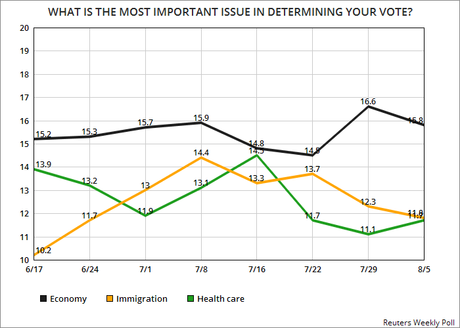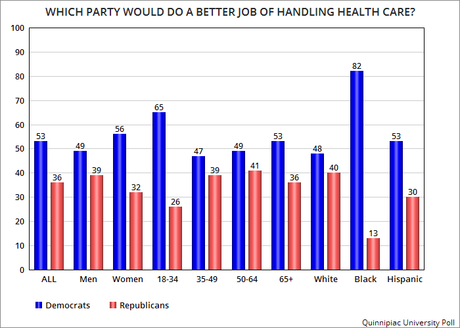

Donald Trump promised while campaigning that he would provide affordable health care for all Americans. And congressional Republicans said they would make insurance more affordable for all Americans. Both lied!
The United States is still a nation with a broken health care system. And that has made health care one of the three leading issues for voters this year (according to the Reuters Weekly Poll). The economy is listed as most important for 15.8% of voters, while immigration (11.8%) and health care (11.7%) are virtually tied for second.
While the crises is bad for Americans, it could help Democrats in the coming election. The newest Quinnipiac University Poll shows significantly more voters think Democrats will do a better job in solving health care problems (53% to 36%).
That's because, after promising to fix the nation's health care problems, the Republicans just made those problems much worse. Their actions just:
1. Resulted in millions more without any kind of health insurance than under the ACA (Obamacare).
2. Caused insurance premiums to sky-rocket.
3. Failed to control medical costs -- which continue to grow faster than inflation, and much faster than worker wages.
But it's even worse than that. About 46.4% (nearly half) of people with poor or only fair health cannot afford to get the medical care they need. That's inexcusable!
Here's how Amanda Michelle Gomez describes the problem in Think Progress:
Nearly one in two sick Americans cannot afford health care, even those with health insurance, according to a new Kaiser Family Foundation analysis. While the Affordable Care Act’s (ACA) coverage expansions and consumer protections have dramatically reduced the uninsured rate to just under 11 percent, the United States still has a massive affordability problem. About 15.5 percent of non-elderly people who have insurance either skipped or delayed medical care, citing cost or inability to pay bills in 2017. This means the total percent of people who struggle to afford care is 26.2 percent when accounting for the under-insured population. “We still have an uninsured problem in the U.S., but we have a far broader health care affordability problem that hits sick people especially hard,” writes Kaiser Family Foundation Drew Altman in his Axios column published Monday. Indeed, nearly half of all people in poor or fair health — or 46.4 percent — are either uninsured or have affordability problems despite having health insurance. “It’s not surprising that people who are sicker and need more care would have more problems paying for it. But arguably an insurance system should work best for people who need it the most,” Altman added. But the insurance system as is doesn’t always help the most vulnerable. Just look at the mental health system. A recent analysis found that patients who need mental health or substance misuse treatment are more likely to have an out-of-network claim, meaning they’re at risk for higher out-of-pocket costs. The ACA helped make coverage more affordable for the insured population. In fact, Obamacare’s most popular provision, pre-existing condition protections, ensures no insurance plan can deny or charge a person more for a medical condition they had before coverage started. However, other health expenses continue to plague patients. Overall cost-sharing payments have outpaced wage growth, as out-of-pocket spending rose by 54 percent while wages increased by 29 percent from 2006 to 2016, according to a recent Peterson-Kaiser Health System Tracker that looked at employer-based plans. This likely explains why health care remains a top political issue ahead of the midterms, explains Altman. “And whatever big policy idea candidates are selling… the candidate who connects that idea to the public’s worries about paying their medical bills is the one who will have found the secret sauce,” he writes. Single-payer plans, a system some progressive candidates have backed, would effectively eliminate all cost-sharing and covers almost all services. However, this isn’t necessarily the case with all Medicare for All plans. Take New York’s single-payer plan, which doesn’t immediately cover long-term care. And currently seniors and people with disabilities are exposed to really high out-of-pocket costs related to long-term care.

